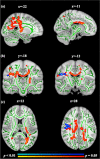Size at birth predicts later brain volumes
- PMID: 37528153
- PMCID: PMC10393952
- DOI: 10.1038/s41598-023-39663-9
Size at birth predicts later brain volumes
Abstract
We aimed to investigate whether gestation at birth, birth weight, and head circumference at birth are still associated with brain volume and white matter microstructure at 9-10 years in children born late-preterm and at term. One hundred and eleven children born at ≥ 36 weeks gestation from the CHYLD Study cohort underwent brain magnetic resonance imaging at 9 to 10 years. Images were analysed using FreeSurfer for volumetric data and tract-based spatial statistics for diffusion data. Of the cohort, 101 children were included for volumetric analysis [boys, 49(49%); median age, 9.5 (range: 8.9-12.4) years]. Shorter gestation at birth, lower birthweight, and smaller birth head circumference were associated with smaller brain volumes at 9 to 10 years, both globally and regionally. Amongst the perinatal factors studied, head circumference at birth was the strongest predictor of later brain volumes. Gestation at birth and absolute birthweight were not associated with diffusion metrics of white matter skeleton. However, lower birthweight z-score was associated with higher fractional anisotropy and lower radial diffusivity. Our findings suggest that even in children born late preterm and at term, growth before birth and timing of birth are still associated with brain development in mid-childhood.
© 2023. The Author(s).
Conflict of interest statement
The authors declare no competing interests.
Figures


References
-
- Volpe JJ. Neurology of the Newborn. 5. Saunders/Elsevier; 2008.
Publication types
MeSH terms
Grants and funding
LinkOut - more resources
Full Text Sources

